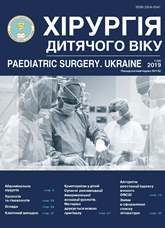Urolithiasis – a chronic and recurrent disease in a girl with multiple congenital anomalies and cerebral palsy– case report
DOI:
https://doi.org/10.15574/PS.2019.64.37Keywords:
urolithiasis, children, recurrence, surgical treatmentAbstract
Urolithiasis is a disease unit more common in adult patients. However in the pediatric population it is also animportant clinical problem due to high risk of recurrence in the patient’s life among others. Hyperkalciuria, hyperuricemia, hyperoxaluria and cystinuria secondary to metabolic disorders promote stone formation.The aim of this study is the presentation of a case of a girl with multiple congenital anomalies, bilateral staghornurolithiasis and bladder stones developing in the course of hypercalcemia.The patient was diagnosed with urolithiasis at the age of 2 months. The course of the disease in her case is characterized by extremely frequent recurrences and numerous urinary tract infections of various aetiology, includinghigh-resistant bacterial strains. These infections were often turbulent and required hospitalization. Due to the extentof urolithiasis, invasive treatment was necessary, both in the lower and upper urinary tract. Endoscopic techniques(transurethral cystolithotrypsy and ureterorenoscopy) were used in urinary bladder and ureter urolithiasis. Renaldeposits were removed by the use of open access surgery (pyelolithotomy with intrarenal lithotrypsy).Although the ongoing development technology and miniaturization of equipment have allowed and popularizedminimally invasive treatment of urolithiasis, some exceptional cases still require surgical treatment with open surgery.The research was carried out in accordance with the principles of the Helsinki Declaration. The study protocolwas approved by the Local Ethics Committee (LEC) of all institutions. No conflict of interest was declared by the authors.References
Lewandowska M., Sybilski AJ. (2013). History of urolithiasis therapy. Prob. Lek. 49(1/2): 88-90.
Sas DJ, Hulsey TC, Shatat IF, Orak JK. (2010, Jul). Increasing incidence of kidney stones in children evaluated in the emergency department. J Pediatr. 157(1): 132-7. doi: 10.1016/j.jpeds.2010.02.004. Epub 2010 Apr 1.
Chen JN, Dieguez LM, Trachtman H. (2014). The Changing Epidemiology of Urolithiasis in Pediatric Patients. J Nephrol Therapeutic. S11: S11-006. doi:10.4172/2161-0959.S11-006
Van Dervoort K et al. (2007). Urolithiasis in Pediatric Patients: A Single Center Study of Incidence, Clinical Presentation and Outcome. J Urol. 177(6): 2300-2305.
Turk C (Chair), Knoll T (Vice-chair), Petrik A, Sarica K, Skolarikos A, Straub M, Seitz C. (2015). Guidelines on urolithiasis, EAU.
Jung A. (1995). Urolithiasis threat, prevention and treatment of urinary stones in children, Agama s.c., Warszawa.
Gadoska-Prokop K. (2007). Leczenie zachowawcze kamicy układu moczowego. Przegląd Urologiczny. 2007/3(43).
Penido MG, Tavares Mde S. (2015, Sep 6). Pediatric primary urolithiasis: Symptoms, medical management and prevention strategies. World J Nephrol. 4(4): 444-54. doi: 10.5527/wjn.v4.i4.444.
Koyuncu H, Yencilek F, Erurhan S, Erydylirim B, Sarica K. (2011). Clinical course of pediatric urolithiasis: follow up data in a long term basis Int. Urol. Nephrol. 43: 7–13.
Bras J. (2016, Jan./Mar). Jornal Brasileiro de Nefrologia. 38, 1. http://dx.doi.org/10.5935/0101-2800.20160014
Horuz R., Sarica K. (2012, Sep 10). The managment of staghorn calculi in children. Arab J Urol: 330-335.
Zargooshi J. (2001). Open stone surgery in children. Is it justified in the era of minimally invasive therapies? BJU Int. 88: 928–31.
Jurkiewicz B., Ząbkowski T., Jobs K., Samotyjek J., Jung A. (2016, Apr 16). Combined Use of Pyelolithotomy and Endoscopy: An Alternative Surgical Treatment for Staghorn Urolithiasis in Children Urol J. 13(2): 2599-604.
Downloads
Issue
Section
License
The policy of the Journal “PAEDIATRIC SURGERY. UKRAINE” is compatible with the vast majority of funders' of open access and self-archiving policies. The journal provides immediate open access route being convinced that everyone – not only scientists - can benefit from research results, and publishes articles exclusively under open access distribution, with a Creative Commons Attribution-Noncommercial 4.0 international license(СС BY-NC).
Authors transfer the copyright to the Journal “PAEDIATRIC SURGERY.UKRAINE” when the manuscript is accepted for publication. Authors declare that this manuscript has not been published nor is under simultaneous consideration for publication elsewhere. After publication, the articles become freely available on-line to the public.
Readers have the right to use, distribute, and reproduce articles in any medium, provided the articles and the journal are properly cited.
The use of published materials for commercial purposes is strongly prohibited.

